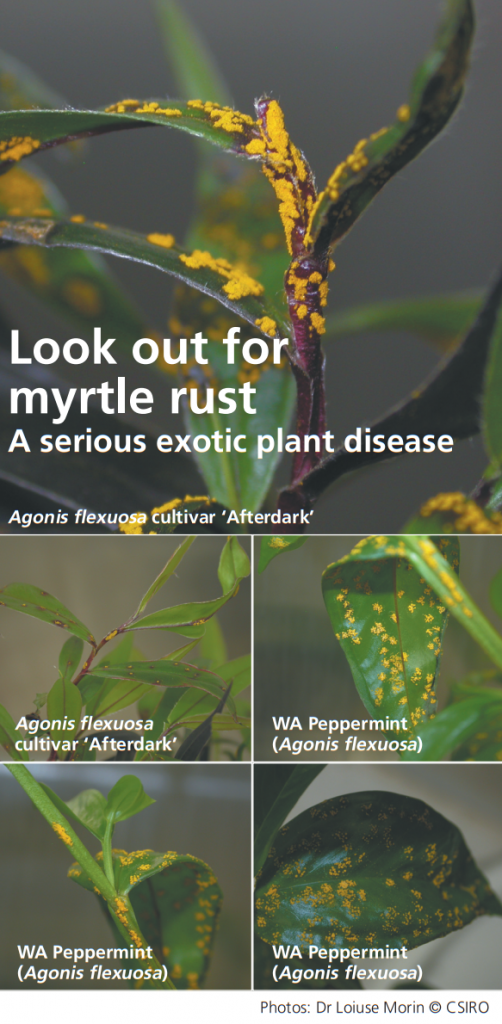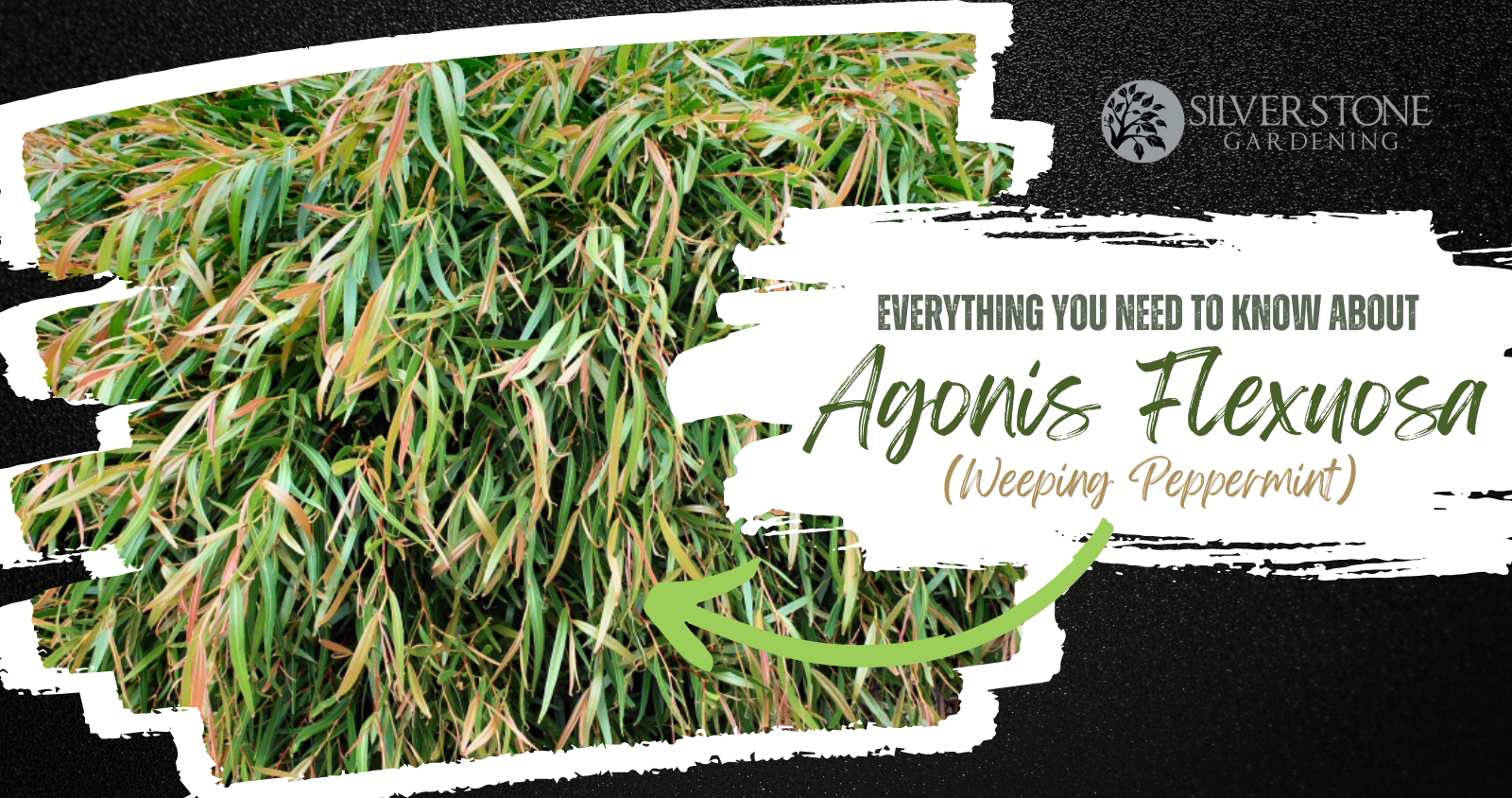
Agonis Flexuosa, also known as the West Australian Weeping Peppermint, is a species of evergreen tree native to Western Australia. It is part of the Myrtaceae family, which also includes other popular species such as eucalyptus and melaleuca.
There are several varieties of Agonis Flexuosa, including the popular “After Dark” which has dark purple foliage, and “Variegata” which has variegated green and white leaves.
Agonis are generally considered to be well-suited to coastal conditions. It is salt-tolerant and can withstand coastal winds, making it a good option for coastal gardens or landscaping. The West Australian Weeping Peppermint is a hardy species and is adaptable to a wide range of soil types, including sandy soils which are common near the coast.
In fact, it is native to the coastal regions of Western Australia, it is well adapted to the harsh coastal conditions and will thrive in such an environment. This species can tolerate salt-laden winds, sandy soils, and dry conditions. It is also drought tolerant and can survive with little water making it an ideal option for coastal gardens or landscaping.
Four popular, but distinct varieties
Agonis Flexuosa
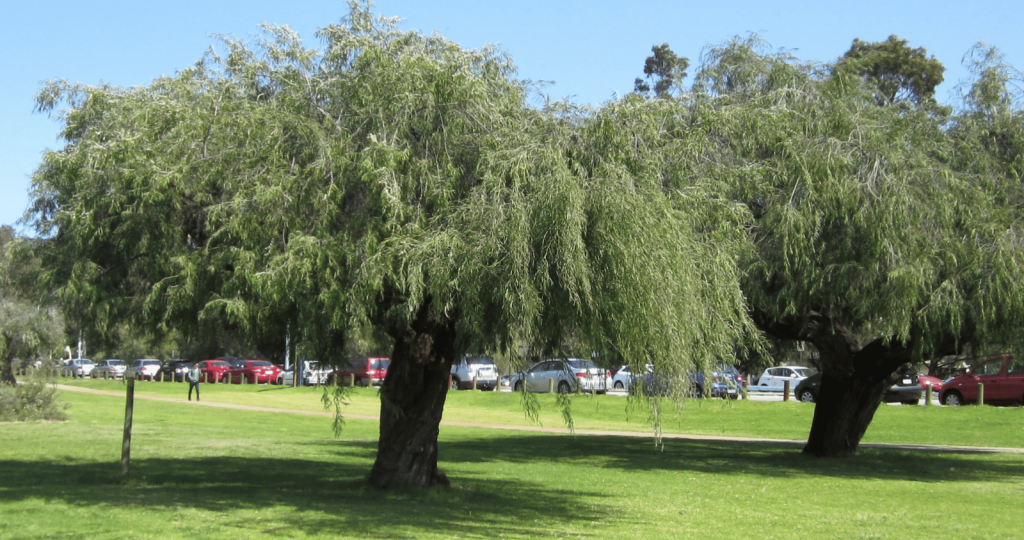
The Agonis Flexuosa tree prefers well-drained soils and can tolerate a wide range of soil pH levels, from acidic to alkaline. It prefers full sun to partial shade, and can tolerate drought conditions once established. It is also tolerant of coastal conditions and salt spray.
One of the most distinctive features of Agonis Flexuosa is its weeping habit, with drooping branches that give it a graceful and elegant appearance. The tree can grow 4-10m tall and 4-10m wide, making it a great choice for larger landscapes. The tree produces small white flowers in spring, followed by small fruit.
The tree is also known for its fragrant leaves which are released when the leaves are crushed. The leaves have a peppermint scent and can be used to make tea. The tree is also popular in essential oil production.
Agonis Flexuosa is a hardy and versatile tree that is well-suited to a wide range of landscaping situations. It is a great choice for large gardens, parks, and streetscapes, and can also be used as a feature tree in smaller gardens. You can find out more info about Agonis Flexuosa here.
Agonis Flexuosa Burgundy

Agonis Flexuosa ‘Burgundy’ is a cultivar of the West Australian Weeping Peppermint tree. It is known for its striking deep red-purple foliage, which makes it an attractive option for gardens and landscapes.
The tree typically grows to a mature height of around 6m, with a similar width. It has a weeping habit, with drooping branches that give it a graceful and elegant appearance. The tree produces small white flowers in spring, which contrast nicely with the dark foliage.
In terms of conditions, ‘Burgundy’ prefers well-drained soils and can tolerate a wide range of soil pH levels, from acidic to alkaline. It prefers full sun to partial shade, and can tolerate drought conditions once established. It is also tolerant of coastal conditions and salt spray.
One of the main reasons why ‘Burgundy’ is an attractive option for a garden is its unique foliage colour. The deep red-purple leaves are a striking contrast to the typical green leaves of most plants, and they create a bold and striking visual impact in any landscape. This cultivar is also great for adding colour and interest to a garden throughout the year.
Another great feature of this tree is that it is relatively low maintenance and is drought tolerant. The tree is also known for its fragrant leaves which are released when the leaves are crushed. The leaves have a peppermint scent and can be used to make tea.
Overall, Agonis Flexuosa ‘Burgundy’ is an attractive and low maintenance tree with unique foliage colour that can add interest and colour to any garden. It is a great option for large gardens, parks, and streetscapes, and can also be used as a feature tree in smaller gardens. You can find out more info about Agonis Flexuosa ‘Burgundy’ here.
Agonis Flexuosa nana

Agonis Flexuosa ‘nana’ is a dwarf cultivar of the West Australian Weeping Peppermint tree. It is known for its compact size and weeping habit, making it an attractive option for small gardens and landscapes.
The tree typically grows to a mature height of around 1 meter, with a similar width. It has a weeping habit, with drooping branches that give it a graceful and elegant appearance. The tree produces small white flowers in spring, which contrast nicely with the dark foliage.
‘Nana’ is an attractive option for a garden due to its compact size. This cultivar is perfect for small gardens, courtyards and patios where space is limited. It’s also great for adding colour and interest to a garden throughout the year without taking up too much space.
Another great feature of this tree is that it is relatively low maintenance and is drought tolerant. The tree is also known for its fragrant leaves which are released when the leaves are crushed. The leaves have a peppermint scent and can be used to make tea.
Overall, Agonis Flexuosa ‘nana’ is an attractive and low maintenance tree with a compact size that can add interest and colour to small gardens and landscapes. It’s a great option for small gardens, courtyards and patios, and can also be used as a feature tree in larger gardens. You can find out more info about Agonis Flexuosa ‘nana’ here.
Agonis Flexuosa Variegata

Agonis Flexuosa Variegata, also known as the Variegated Weeping Peppermint, is a cultivar of the West Australian Weeping Peppermint. It is a small to medium-sized shrub that grows to a maximum height of around 10 meters, and about 4 meters wide.
One of the most striking features of Agonis Flexuosa Variegata is its variegated foliage, which is a mix of green and cream-colored leaves. This makes it an attractive option for a garden, as it adds visual interest and texture.
In terms of growing conditions, Agonis Flexuosa Variegata prefers well-draining soil and full sun to partial shade. It is drought-tolerant and can survive with little water, but it does best when it is watered regularly. This cultivar is also salt-tolerant and can withstand coastal winds, making it a good option for coastal gardens or landscaping.
It should be pruned in order to maintain its shape and size, and to encourage bushiness. Spring and summer are the best time of year to prune and it should be fertilized once a year with a slow-release fertilizer.
This cultivar is suitable for Mediterranean gardens, rock gardens, coastal gardens, and low-maintenance gardens. It also makes a great hedge or screen, and can be used as a specimen plant in a mixed border.
Overall, Agonis Flexuosa Variegata is an attractive and versatile option for a garden due to its variegated foliage, tolerance of a wide range of growing conditions, and its low-maintenance nature.
Are Agonis Flexuosa considered drought tolerant?
Yes, Agonis Flexuosa is considered drought tolerant. Once established, it can tolerate dry conditions and can survive with minimal water.
How much water does Agonis Flexuosa need?
The water requirements of Agonis flexuosa can vary depending on the specific cultivar and the conditions in which it is grown. However, on average, the tree requires around 10-20mm of water per week, depending on weather conditions and the maturity of the tree. It is important to note that, newly planted trees will require more frequent watering to help establish their root systems, and mature trees can tolerate longer periods of drought.
How often should Agonis Flexuosa be pruned?

Agonis Flexuosa should be pruned as needed to maintain its shape and size. This can vary depending on the specific cultivar and the conditions in which it is grown.
Larger varieties can be pruned annually, biennially or as needed to remove any damaged, diseased or crossed branches. Due to their weeping habit it is most common to need to lightly trim some weeping branches so that the tree can be walked under without the dropping leaves brushing against people.
Smaller varieties like Agonis Flexuosa ‘Nana’ can be used as a hedge, to maintain a hedge ‘Nana’ would need to be hedged every 6-12 weeks once it has reached the desired size of the hedge.
When is the best time of year to prune?
The best time to prune Agonis Flexuosa is typically in late winter or early spring before new growth begins. Pruning at this time allows for easy visibility of the tree’s structure and makes it easier to identify any damaged or diseased branches. Additionally, pruning during the dormant season can help to promote new growth and better overall health of the tree. If maintaining a hedge or specific shape then prune as needed.

How quickly do Agonis Flexuosa grow to their full height?
The growth rate of Agonis Flexuosa can vary depending on the specific cultivar and the conditions in which it is grown. However, on average, it can take several years for the tree to reach its full height. A mature tree can reach a height of around 6-10 meters
How many meters does a Agonis Flexuosa grow in a year?
The annual growth rate of Agonis Flexuosa can vary depending on the specific cultivar and the conditions in which it is grown. However, on average, it can be expected to grow between 0.5 to 1 meter per year. This rate can be affected by factors such as sunlight, water, soil, and climate.
Should Agonis be fertilised?

Yes, Agonis Flexuosa should be fertilized to promote healthy growth and maintain overall tree health. However, It is generally not recommended to fertilise a newly planted Agonis Flexuosa right away. It is best to wait until the plant is established and has developed a healthy root system before applying fertiliser.
When a plant is newly planted, it is in a delicate state and its root system is still adjusting to its new environment. Applying fertiliser too soon can be stressful for the plant and can cause damage to the roots. This can lead to the plant being less able to absorb the water and nutrients it needs to survive.
It is also important to note that too much fertiliser can burn the roots and cause damage to the plant, it is best to avoid over fertilisation.
It is recommended to wait for about 4-6 weeks after planting before fertilising Agonis Flexuosa. This will allow the plant time to adjust to its new environment and develop a strong root system. Once the plant is established, you can begin to fertilize it according to the specific requirements of the cultivar and the growing conditions.
What fertiliser is best for Agonis?
A slow-release, balanced fertiliser is best for Agonis Flexuosa. Choose a fertiliser that is designed for Australian natives that contains a mix of nitrogen, phosphorous and potassium. Here is a great balanced organic fertiliser that can be used on just about every plant.
How do you apply fertiliser to an Agonis?
Fertiliser should be applied around the base of the tree, and spread evenly out to the dripline. It is important to water the tree thoroughly after fertilising to help the nutrients to reach the root zone. Adding a wetting agent will also help water get down the roots and benefit the overall health of the plant.
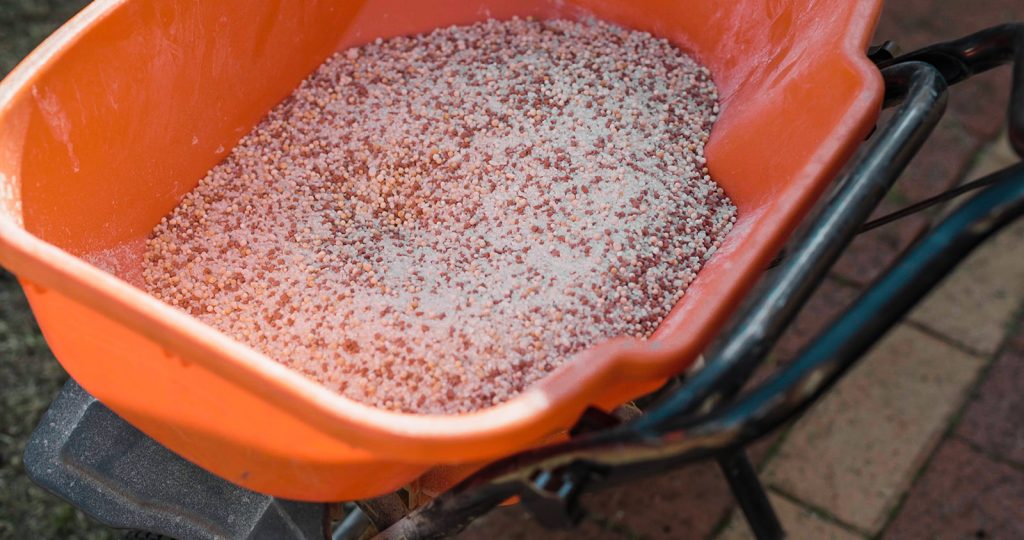
How often should Agonis be fertilised?
If using a slow release fertiliser Agonis flexuosa should only need to be fertilised once a year, typically in late winter or early spring before new growth begins. It is important to follow the manufacturer’s instructions and not to over fertilize as this can lead to leaf burn and other damage.
If you are trying to encourage faster growth or a more dense hedge then more regular fertilisation may be needed. Read the label/instructions of the fertiliser you have chosen to find how long the fertiliser lasts (some may say 6-8 week, others 3 months or even 6 months). Reapply the fertiliser after your previous application has run its course.
What pests are common with Agonis Flexuosa?

Common Pests of Agonis Flexuosa: Agonis Flexuosa is generally considered to be pest-free, but some common pests that can affect the tree include:
- Scale insects: These are small, hard-shelled pests that attach themselves to the leaves and branches of the tree. They can cause leaf yellowing, wilting, and dieback.
- Mites: Spider mites are tiny, spider-like pests that can cause discoloration and stunted growth. They can also cause webbing on the foliage.
- Caterpillars: These can cause defoliation and damage to the tree. Aenetus dulcis – Australian Lepidoptera caterpilars have been known to bore into the stems of Agonis Flexuoa http://lepidoptera.butterflyhouse.com.au/hepi/dulcis.html
- Sawfly: These insects can cause leaf damage, and heavy infestations can cause defoliation.
It’s important to keep an eye out for these pests and take action if you notice them on your Agonis Flexuosa. Regular inspections can help you identify problems early, before they become too severe.
What diseases are common with Agonis Flexuosa ?
Common Diseases of Agonis Flexuosa: Agonis flexuosa is generally considered to be disease-free, but some common diseases that can affect the tree include:
Myrtle Rust
Myrtle rust is a fungal disease that can cause significant damage to Agonis flexuosa, also known as West Australian Weeping Peppermint. The fungus (Austropuccinia psidii) affects plants in the Myrtaceae family, which includes Agonis flexuosa.
When the fungus infects Agonis flexuosa, it causes the leaves to develop bright yellow or orange spots. These spots can also appear on the stems and branches of the plant. As the disease progresses, the leaves may become distorted, curled and wilted, and the plant may become stunted.
The fungus can also infect the flowers, causing them to become discolored and fall off prematurely. This can lead to reduced fruit production and overall plant health.
One of the most noticeable symptoms of myrtle rust on Agonis flexuosa is the formation of small, bright yellow or orange spores on the undersides of the leaves. These spores can be easily spread by wind or water, making it easy for the fungus to infect other plants in the surrounding area.
In severe cases, myrtle rust can cause the death of infected plants. It is important to take action quickly if you suspect that your Agonis flexuosa has been infected with myrtle rust.
To prevent myrtle rust from damaging your Agonis flexuosa, it is important to keep the area around the plants free of debris and to avoid overcrowding the plants. Regularly inspecting the plants for signs of infection and taking action as soon as you notice any symptoms.
If you suspect that your Agonis flexuosa is infected with myrtle rust, it is important to seek the advice of a professional horticulturist or plant pathologist as soon as possible. They can help you determine the best course of action to save your plant and prevent the spread of the fungus.
Root Rot
This is a fungal disease that can cause yellowing and wilting of leaves, as well as dieback of branches. It is caused by overwatering or poorly drained soils.
Agonis Flexuosa do not need much water and do best in free draining soil. If you are having this issue reduce watering days to once per week to let the soil dry out between watering days.
It’s important to keep an eye out for these diseases and take action if you notice them on your Agonis flexuosa. Regular inspections can help you identify problems early, before they become too severe. Proper cultural care like proper watering, good drainage and proper pruning can help prevent these diseases.
Are agonis flexuosa roots invasive?

Agonis flexuosa is known to have a relatively non-invasive root system, meaning that the roots do not typically spread far beyond the dripline of the tree. This makes it a suitable choice for planting in smaller gardens or near structures where invasive roots could be a problem. However, it’s still important to consider the mature size of the tree and provide enough space for the tree to grow without causing damage to surrounding structures or landscaping. Additionally, it is still important to be mindful of the tree’s root system when planting and make sure to provide adequate drainage and avoid planting in heavy clay soils as these can cause issues with waterlogging and root rot.
Will my Agonis Fexuosa damage my lawn?
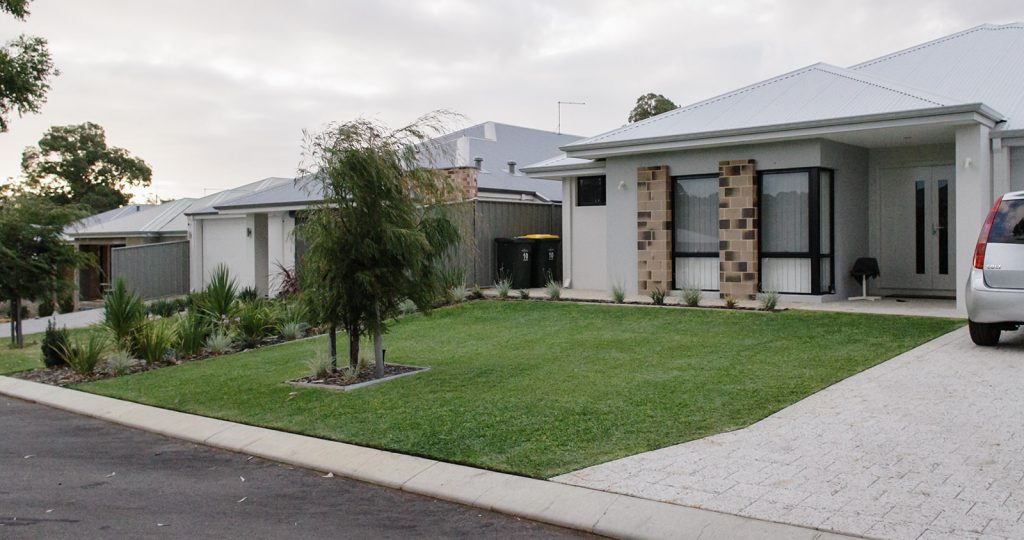
Agonis Flexuosa is generally considered to be a tree that will not cause direct damage to a lawn. The tree’s root system is not known to be invasive, and it typically does not cause damage to nearby structures or landscaping.
However, it’s still important to consider the mature size of the tree and provide enough space for the tree to grow. If a tree is planted in the middle of a lawn, as the tree matures it will cast more and more shade on to the lawn which will have a negative effect on a lawn. Most lawns will not strive directly under an Agonis Flexuosa canopy. So if space is tight choose a dwarf variety, or even a different tree.

Can you over water Agonis Flexuosa?
Yes, Agonis Flexuosa can be overwatered, which can cause a number of problems. Overwatering can lead to waterlogged soil, which can suffocate the tree’s roots and prevent them from getting the oxygen they need. This can lead to root rot, which can cause yellowing and wilting of leaves, as well as dieback of branches. Overwatering can also lead to an increase in pests and diseases, such as Phytophthora root rot, which is a fungal disease caused by waterlogged soil.
It’s important to be mindful of the tree’s water requirements and make sure to provide adequate drainage. Agonis Flexuosa prefers well-draining soil and should not be planted in heavy clay soils. Additionally, it’s important to not water the tree too frequently and ensure that the soil can dry out between waterings.
A good practice is to check the soil moisture before watering, if the soil is still wet then it’s not necessary to water. Agonis Flexuosa is considered to be drought tolerant, it can survive with less water, but it will thrive with regular watering during summer.
Why are my Agonis Flexuosa leaves curling?
There are several reasons why the leaves of Agonis flexuosa may be curling:
- Environmental stress: Curling leaves can be a sign of stress caused by environmental factors such as extreme heat, cold, or wind. Make sure to protect your tree from harsh weather conditions if possible and also consider if your tree is getting enough water and sunlight to keep healthy. (This product helps the plant become more resilient to stress.)
- Pests: Curling leaves can also be a sign of a pest infestation. Some common pests that can affect Agonis Flexuosa include spider mites, aphids and scale insects. Check your tree for any signs of these pests and take appropriate action if necessary.
- Disease: Curling leaves can be a symptom of a fungal or bacterial disease. Agonis flexuosa is susceptible to Phytophthora root rot, which is a fungal disease caused by waterlogged soil. Other fungal diseases such as powdery mildew can also cause leaf curling. (Here is an organic fungicide that will help with Powdery Mildew and Black Spot.)
- Nutrient deficiency: Curling leaves can also be caused by a deficiency in essential nutrients such as nitrogen, potassium, or magnesium. Make sure to fertilize your tree regularly and with the appropriate fertilizers.
- Herbicide damage: If the tree is exposed to herbicides (either by accident or by design) it can cause leaf curling. Make sure that any herbicides used nearby are not harmful to Agonis Flexuosa.
It’s important to identify the cause of the leaf curling in order to take appropriate action. If the problem persists or if the tree shows other symptoms such as wilting or dieback, it’s best to consult with a professional arborist or a horticulturist for further assessment.
